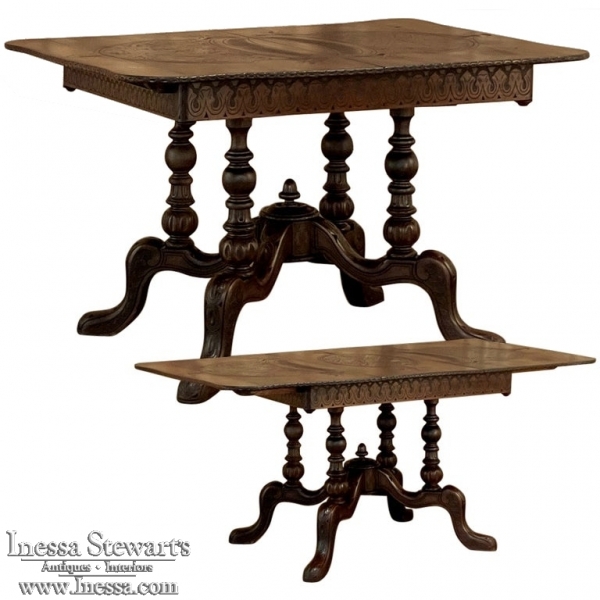19th Century Dining Table by Horrix with Original Carved Leaf
2905-8596 (Click to Inquire About This Item)
31.5H x 50W x 39.5D; opens to 69W
Location: Dallas
19th Century Dining Table by Horrix with Original Carved Leaf is yet another example of the superlative craftsmanship exhibited by the storied maker during the period. Set upon an unusual base with four turned pedestals atop a boldly scrolled four-legged structure, it features an apron carved on all four sides that conceals a pocket into which the single original carved leaf can be housed until needed. The legs are not only turned but tastefully carved, and the scrolled base features intricate carved detail as well, with the four legs converging at the center topped with a roundel and acorn finial. The carvings on the apron depict a repeating foliate design, foreshortened on the short side that contains the slot for the leaf. In a trademark feature, the table top itself is carved with three distinct motifs ~ one glorifying ripe pears on the tree, the other fully laden grapevines, while the leaf is carved with apples ready to be picked from the tree, all carved in incredible intaglio and bas relief style. Even the edge of the table has been carved with a stylized Greek coin pattern!
Circa 1880s
Measures 31.5H x 50W x 39.5D; opens to 69W
In the mid-19th century, the brothers Matthew Sr. (1815-1889) and Willem Horrix Sr. (1816-1881) continued in their family's business passed along from their father Pieter Paulus (1767 to 1840). The company was founded in 1790/91 by Mathijs Horrix (1735-1809). Eventually, Matthew & Willem's own sons Matthew Jr. (1845-1923) and Willem Jr. (1848-1902) would continue in the family tradition.
These Dutch cabinetmakers were established in The Hague, and gained fame during the so-called "eclectic period" during the 19th century. Their work was inspired by older styles of furniture, but with fashionable features that was then considered "new".
The company also made rustic style furniture that was very popular in the Northern Countries and England. These unusual objects entered the interiors of upper class houses especially popular in Biedermeyer styles in Germany, and Black Forest styles in Switzerland.
Horrix enjoyed highly acclaimed success and thanks to their good reputation, they were asked in 1883 to built the royal throne of William III of the Netherlands.










































